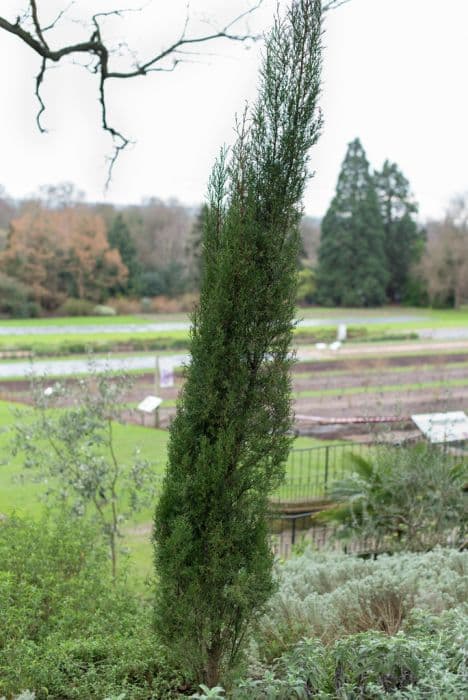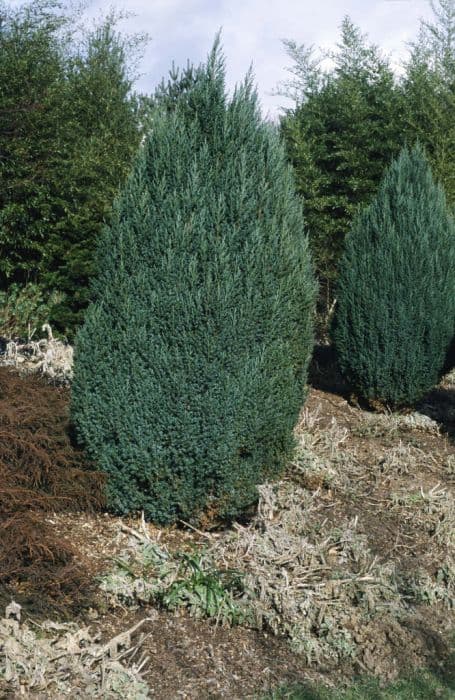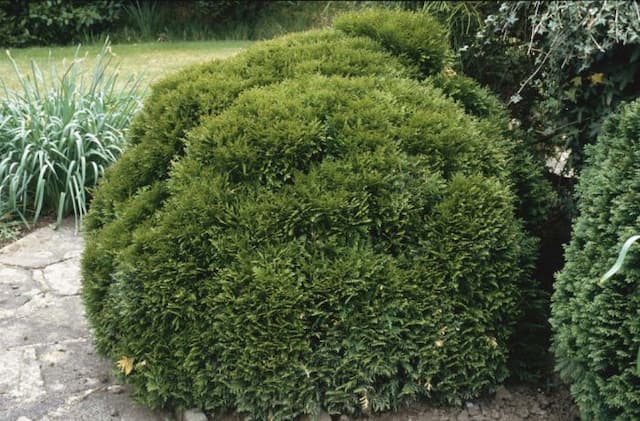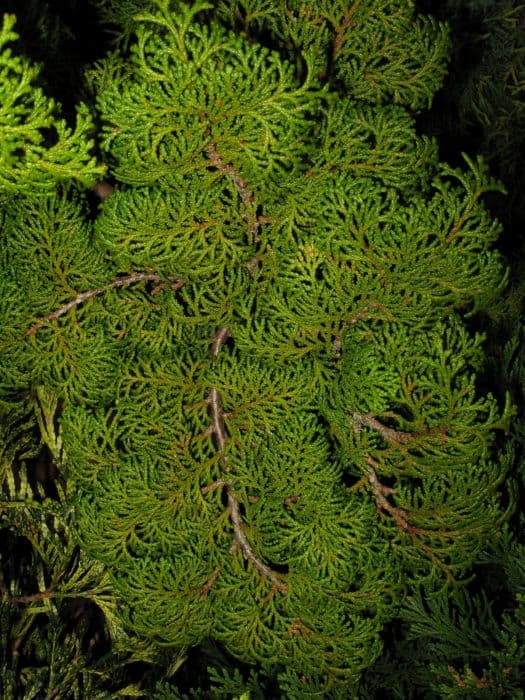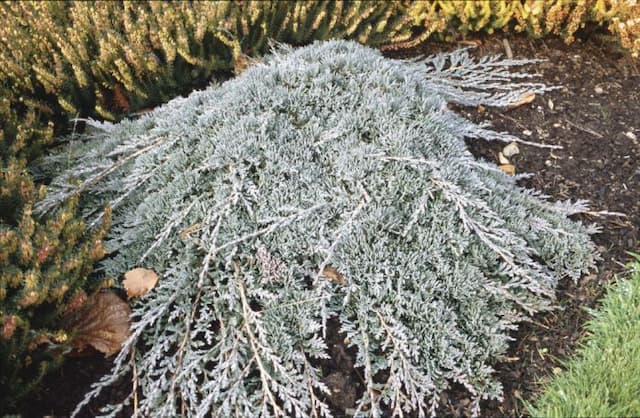Lawson Cypress Chamaecyparis lawsoniana 'Kilmacurragh'











ABOUT
The plant commonly known as Lawson's Cypress 'Kilmacurragh' is an evergreen conifer with a distinctive appearance. Its foliage comprises scale-like leaves that are tightly arranged in a flattened, spray pattern, exuding a lush, dense quality. The leaves themselves present a soft texture to the touch and are often a rich green color, with some variations depending on the season or specific conditions. This plant showcases a conical form, narrowing towards the top, which gives it an elegant and stately presence in the landscape. The branches tend to grow horizontally, more or less symmetrical around the trunk, which contributes to its balanced look. It might exhibit a slightly open habit, allowing glimpses into the inner structure of the tree. One of its most notable features is the bark, which is fibrous and vertically furrowed, creating an interesting textural contrast with the smoothness of the leaves. The color of the bark ranges from reddish-brown to grayish, peeling off in narrow strips which may catch the eye upon closer inspection. The cones are another characteristic element, though they are typically small and may not be immediately noticeable. They are globular, with small scales and usually come in a brownish or grayish hue, blending in with the foliage. Overall, the Lawson's Cypress 'Kilmacurragh' is known for its refined, soft aesthetic and its rich green foliage, providing an attractive year-round display for any garden or landscaped area.
About this plant
 Names
NamesFamily
Cupressaceae.
Synonyms
Lawson's Cypress, Oregon Cedar, Port Orford Cedar.
Common names
Cupressus lawsoniana, Chamaecyparis lawsoniana, Callitropsis lawsoniana.
 Toxicity
ToxicityTo humans
The plant commonly known as Port Orford cedar (Chamaecyparis lawsoniana) is not typically considered highly toxic to humans. However, some people may experience skin irritation or allergic reactions after handling the foliage or sawdust. If ingested, the plant material may cause gastrointestinal discomfort, such as nausea, vomiting, or diarrhea. Ingestion of significant quantities is uncommon and generally not life-threatening but can be more serious for young children and individuals with specific sensitivities.
To pets
Port Orford cedar (Chamaecyparis lawsoniana) is not widely recognized as a toxic plant to pets. However, as with many non-food plants, ingestion of significant amounts may lead to gastrointestinal upset in animals such as dogs and cats. Symptoms could include vomiting, diarrhea, or abdominal pain. It is always best to prevent pets from consuming plants that are not intended for their diet to avoid any potential issues.
 Characteristics
CharacteristicsLife cycle
Perennials
Foliage type
Evergreen
Color of leaves
Green
Height
40 feet (12 meters)
Spread
15 feet (4.6 meters)
Plant type
Tree
Hardiness zones
5
Native area
North America
Benefits
 General Benefits
General Benefits- Ornamental Value: Lawson's Cypress 'Kilmacurragh' has a distinctive, pyramidal shape and attractive foliage, making it a popular choice for landscape design and ornamental gardens.
- Privacy Screen: Due to its dense growth habit, it can serve as an effective natural privacy screen or windbreak.
- Habitat for Wildlife: It provides shelter and nesting sites for birds and other wildlife.
- Soil Stabilization: The root system helps prevent soil erosion on slopes and in landscapes.
- Low Maintenance: Once established, it requires minimal care apart from occasional pruning to maintain its shape.
- Drought Tolerance: It can withstand periods of dry weather once it is established, reducing the need for frequent watering.
 Medical Properties
Medical PropertiesThis plant is not used for medical purposes.
 Air-purifying Qualities
Air-purifying QualitiesThis plant is not specifically known for air purifying qualities.
 Other Uses
Other Uses- Woodworking: The wood of the Lawson Cypress can be used in fine woodworking projects, including cabinetry and veneers, due to its fine grain and attractive appearance.
- Aromatic Oils: The foliage can be processed to extract essential oils that are used for perfuming soaps and other aromatic products.
- Horticultural Art: Its flexible branches are sometimes used in topiary, allowing gardeners to shape it into various artistic forms.
- Sound Barrier: Planted in rows or hedges, the Lawson Cypress can act as an effective sound barrier, dampening noise from roads and neighbors.
- Windbreaks: They are effective as windbreaks on properties, reducing soil erosion and protecting more delicate plants.
- Habitat Creation: When planted in groups, they provide shelter and habitats for various species of birds and other wildlife.
- Privacy Screening: Due to its dense foliage, it is commonly used to create private spaces within gardens and parks.
- Christmas Trees: Some varieties of Lawson Cypress are grown as Christmas trees because of their conical shape and dense branches that hold ornaments well.
- Urban Green Spaces: They are planted in urban areas to add greenery and improve the aesthetics of concrete-dominated environments.
- Soil Stability: Their root systems can help stabilize soil on slopes, preventing landslides and soil erosion.
Interesting Facts
 Feng Shui
Feng ShuiThe Lawson cypress is not used in Feng Shui practice.
 Zodiac Sign Compitability
Zodiac Sign CompitabilityThe Lawson cypress is not used in astrology practice.
 Plant Symbolism
Plant Symbolism- Longevity: Also known as Lawson's Cypress, this plant is an evergreen conifer, symbolizing its enduring nature and the ability to withstand the test of time.
- Endurance: Its hardiness in various environments represents the ability to persevere and adapt through different challenges.
- Sanctuary: The dense foliage of Lawson's Cypress offers shelter and privacy, symbolizing a safe haven or refuge.
- Peace: Its use in gardens and cemeteries conveys a sense of tranquility and restfulness.
 Water
WaterThe Port Orford cedar should be watered deeply once a week, providing about 1 to 2 gallons of water for smaller plants and up to 10 gallons for mature trees. During hot and dry periods, the frequency may need to increase to twice a week. Ensure that the soil is well-drained to prevent root rot, but it should remain consistently moist. Water at the base of the plant, avoiding wetting the foliage, and early in the morning to allow for evaporation. Reduce watering in the winter when the plant is not actively growing.
 Light
LightThe Port Orford cedar thrives in full sun to partial shade. It is best to place the plant in a spot where it will receive at least six hours of direct sunlight a day, but it can also tolerate areas with dappled light. Avoid exposure to intense afternoon sun in very hot climates, as this can stress the plant.
 Temperature
TemperatureThe Port Orford cedar prefers cooler climates and can tolerate temperatures down to -20°F but may not do well in climates where the temperature regularly exceeds 90°F. The ideal temperature range for this plant would be between 60°F and 75°F. Protect the tree from harsh winter winds which can cause desiccation and browning of the foliage.
 Pruning
PruningPruning the Port Orford cedar should be done to maintain its shape, remove dead or diseased branches, and to encourage new growth. The best time for pruning is late winter or early spring before new growth starts. Light pruning can also be done in summer if necessary. However, avoid heavy pruning as it does not respond well to cutting into old wood, and always use sterilized tools to prevent the spread of disease.
 Cleaning
CleaningAs needed
 Soil
SoilFor the Port Orford cedar, use a well-draining soil mix with equal parts peat, coarse sand, and perlite or pumice. Aim for a slightly acidic to neutral pH between 6.0 and 7.0.
 Repotting
RepottingPort Orford cedar should be repotted every 3-4 years or when it outgrows its current container to maintain healthy growth.
 Humidity & Misting
Humidity & MistingThe Port Orford cedar thrives in moderate to high humidity levels, ideally between 40-60%.
 Suitable locations
Suitable locationsIndoor
Port Orford cedar requires bright light and cool temperatures indoors.
Outdoor
Plant in well-draining soil, full sun to partial shade.
Hardiness zone
6-8 USDA
 Life cycle
Life cycleLawson's Cypress 'Kilmacurragh' begins its life as a seed, which requires a period of stratification to break dormancy and promote germination. Upon germination, the seedling stage is characterized by initial root and shoot development, with the young plant being particularly vulnerable and requiring appropriate light, water, and soil conditions. As it enters the juvenile phase, the plant experiences rapid vegetative growth, establishing a strong root system and developing its characteristic scale-like foliage and conical habit. Maturity is reached over several years, and the plant begins to produce cones—female cones are green and globular, turning brown as they mature, while male cones are smaller and release pollen in the spring. During its reproductive stage, pollinated cones develop seeds that are dispersed to initiate new life cycles. The Lawson's Cypress 'Kilmacurragh' can have a lifespan of over 100 years, with the mature phase lasting many decades under suitable growing conditions.
 Propogation
PropogationPropogation time
Late winter-early spring
Propogation: The most popular method of propagation for Chamaecyparis lawsoniana 'Kilmacurragh', commonly known as Lawson's cypress, is through semi-hardwood cuttings. This process typically occurs in late summer. Healthy, disease-free shoots from the current year's growth are selected and cut into lengths of 4 to 6 inches (approximately 10 to 15 centimeters). The lower needles are removed, and the cut end may be dipped in rooting hormone to encourage root development. The prepared cuttings are then inserted into a well-draining potting mix and maintained in a humid environment until roots are well established, which can take several months. It's crucial to keep the cuttings out of direct sunlight and ensure the soil remains moist but not waterlogged to promote successful rooting.
